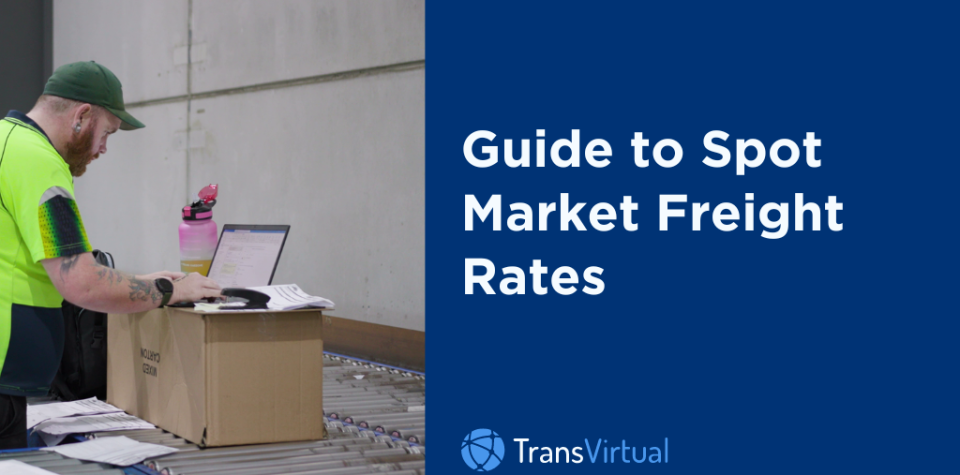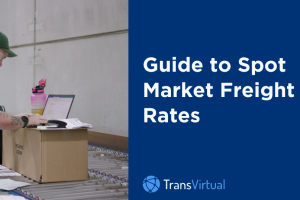Table of Contents
If you work in shipping and transport, most of your shipments are likely handled by contracted carriers with whom you have a continuous relationship.
However, there are times when your shipping carrier can’t support you: such as when there is a sudden spike in demand, an emergency, or disruptions in global trade impacting shipping container capacity.
In those instances, you might need to get a spot quote – an instantaneous quote from another carrier that can make up for the lack of capacity ‘on the spot’.
This type of thing might be common during busy holiday seasons, but we also saw a 17% increase in overall spot rates in August 2020, when uncertainty drove businesses to avoid committing to contracts.
Fluctuations in shipping capacity, influenced by factors like port congestion or peak season also triggers the need for spot quotes.
If you’re curious about what it is, how it works, read on – this is your ultimate guide to freight spot rates.
What is a Spot Market Quote?
A spot quote is a rate offered by a carrier outside of your standard contract rates. It may be provided when you have urgent shipments to make or when your usual carrier doesn’t have the capacity you need.
Spot quotes tend to expire in a much shorter time, and the freight rates depend on current market conditions. Various factors such as regulatory changes, seasonal fluctuations, geopolitical landscape, and oil prices can influence spot freight rates, making their pricing often more volatile and unpredictable.
As a result, they are not suited for long-term plans or regular shipments, as this will undoubtedly start to cut into your profit margins.
Seasonality can significantly impact the volatility of spot quotes, especially during holidays and peak seasons.
However, even if you’re not looking at spot quotes to pay for extra capacity, it’s worth keeping an eye on the going rates. Spot quotes reflect the current market and are often good indicators of the direction contract rates are heading.
The Spot Quote Process – How Do Freight Rates Work?
A streamlined spot quote process can easily be summarised in just four steps:
Contact a carrier or freight forwarder to request a quote.
This can be done via phone, email, or digital contact forms. Suppose you don’t have an automated process for this. In that case, you’ll need to send out one request at a time, which can be a tedious and lengthy affair, especially when you are in a time crunch.
Outline the details of your shipment.
Just like with contractual quotes, carriers need to know the shipment weight, load type, dimensions, origins and destination and the deadline for your shipping request. This adds more time to the process.
Wait for the carrier’s rates.
The carrier will get back to you with a spot quote. Be careful no miscalculations or miscommunications occurred during the previous steps as this can lead to further delays. Review the spot quote for accuracy.
Compare spot quotes
To get the best freight rates, as with any quote, you will want to contact a few different carriers to compare prices. Comparing spot quotes manually is another time-consuming part of the process. Understanding the spot market is crucial when comparing spot quotes, as it reflects the real-time balance of supply and demand.
How Spot Quotes Differ From Other Quotes

Spot quotes are different from contract quotes.
First, they are fast and spontaneous, whereas contract quotes are worked out ahead of time due to their more complex and long-term nature. Understanding market rates often involves using a freight rate index, which aggregates and anonymizes real-time business data from global freight carriers, freight forwarders, and shippers to calculate benchmark or market rates for freight.
Contract quotes are the outcome of the long-term analysis and rely on a continuous working relationship with a carrier. The Shanghai Containerized Freight Index (SCFI) is one such index, and it is often compared to other indices like the FBX to provide visibility into freight rates for interested parties.
As a result, they benefit from precise forecasting. In addition, they are often negotiated in greater depth to get the best deals for months or even a whole year of shipments.
The key differences between spot quotes and contract quotes are:
Time
Contract quotes are often negotiated over a longer period, requiring detailed cost analysis and forecasting. Spot quotes, on the other hand, are expected very quickly.
Relationship
Contract quotes need to be beneficial to both the carrier and the business they partner with because they are entering a long-term relationship. Spot quotes don’t require a partnership.
They are one-time collaborations, so you don’t have to be quite familiar with the carrier.
Load Type and Destinations
Contract quotes are founded on a substantial quality of shipments at a load-to-truck ratio. In contrast, spot quotes are available for smaller shipments.
Also when it comes to destinations, contract quotes can cover shipments that go to various destinations with different regulations. This is another aspect that goes into the negotiation.
Doing this with spot quotes is nearly impossible because it takes time to properly analyse and prepare for multiple regional regulations.
Start-up Friendly
Spot quotes work well for businesses just starting on a new avenue. They can act as stepping stones until you understand the shipping procedure better and get regular orders that warrant a contract with a carrier.
Contract quotes require you to commit to a larger investment over time, which not all small businesses can do.
Freight Spot Quotes: Best Practices in Supply Chains
Last but not least, here are a few things to keep in mind when you request a spot quote:
Understanding freight dynamics is crucial. Factors such as sudden price increases, capacity crunch, and market rates for container shipping on major global trade routes can significantly impact your shipping costs.
Say for example you’re availing of ocean freight rates. Events like the Red Sea diversions, port congestion, bad weather, and demand levels can all affect ocean freight rates and shipping capacity.
If possible, you may wish to avoid carriers new to your route or who don’t typically handle carrier requirements similar to your own. Carriers more familiar with your route or type of freight are generally more reliable, as they have more experience.
Always be sure to provide accurate shipping details. This ensures you and potential carriers don’t spend unnecessary time working out miscommunications and inaccurate rates.
Try to get your spot rates in advance if possible. Shippers usually request spot rates 1-2 days before the shipping dates. The sooner you realise you will need extra shipping, the better.
More time will allow you to get in more quotes and compare them more thoroughly, so many advise against taking the first price you get. But remember, spot quotes can change week by week, so if you get a quote you like, don’t wait to lock it in with your carrier!
Logistics software can speed up the process to put you in touch with multiple carriers automatically so that you can compare and benefit from the best quotes. With spot quotes, time is of the essence. You don’t want to be left in a situation where you have to go with a less than ideal price because you don’t have time to find another.
Supply chain disruptions, such as port congestion and container shortages, can also impact the need for spot quotes, making it essential to plan ahead and stay informed.
Enjoy Better Spot Quotes Next Holiday Season Amid Seasonal Fluctuations
If you’re stressed about meeting holiday demand, it’s time to get familiar with spot quotes and prepare your process for the next season. Potential labor negotiations on the East Coast could cause delays and impact the shipping industry, making it crucial to plan ahead.
Get in touch or book a free demo today. Our logistics software automatically identifies carriers with the best rates for your business so you can access spot quotes as soon as you need them. Additionally, the Red Sea crisis is putting increased pressure on shipping capacity, leading to longer transits and impacting shipping rates.


